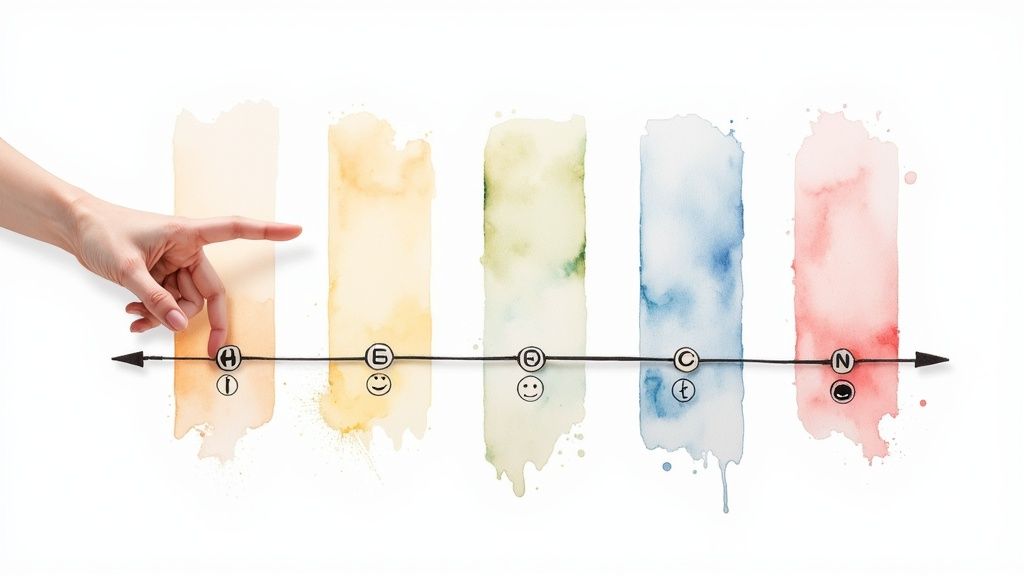Stop Asking Useless Survey Questions. Steal These Instead.
Stop guessing. Get battle-tested survey questions examples to find out what your customers actually want. Real talk, no fluff. Just actionable insights.
Posted by
Related reading
Customer Advisory Board: The Founder's Playbook for Avoiding Catastrophic Mistakes
A practical guide to building a customer advisory board that provides honest insights, validates your strategy, and prevents costly product mistakes.
Why Reputation Management Tools Matter More in 2025 Than Ever
Learn how reputation management tools help businesses track reviews, analyze feedback, and protect brand image. A modern guide with AI-driven insights using Backsy.
Sentiment Analysis Isn’t a “Nice-to-Have”. It’s a Lie Detector for Your Product.
Founders love chasing features, but customers speak in emotions. Learn what sentiment analysis really is, how it works, and how it reveals the truth behind your feedback. No fluff.
Alright, let's cut the crap. You think you're getting honest feedback, but you're not. You're sending out boring, corporate-speak surveys that train your customers to give you sterile, useless answers. You get back a 4.2-star average and pat yourself on the back while your churn rate quietly climbs. I've been there. I burned six figures on a product nobody wanted because I asked the wrong questions in the wrong way.
Voice of Customer isn't about 'listening.' It's about surgically extracting the truth, even when it stings. Ignore your customers, and you’ll be lucky to survive the quarter. We're not talking about politeness; we're talking about getting answers that build a product people will actually pay for. To truly stop forcing customers to lie, leveraging advanced approaches such as modern survey tools, potentially powered by AI can uncover deeper, more authentic insights.
This isn't a collection of fluffy templates. It's an armory of battle-tested survey questions examples. Each one is a tool designed to dismantle your assumptions and expose what your customers actually think.
1. Multiple Choice Questions (MCQ): Your Necessary Evil
MCQs box respondents into your predefined answers. It’s their biggest strength and their fatal flaw. You get clean, easy-to-analyze data for spotting trends, but you're forcing a choice.

Use them to get hard numbers on things you already suspect or need to segment. Don't use them for discovery; that's like asking a fish to describe the sky. You’ll just get a reflection of your own biases. For a guide on crafting questions that don't sabotage each other, see how to create a questionnaire.
The Takeaway: Use MCQs to count things you already know exist, not to find things you don't.
2. Likert Scale Questions: Gauging the Squishy Stuff
Likert scales turn fuzzy feelings into hard numbers. Respondents rate agreement on a 5 or 7-point scale. This is how you stop guessing what people think and start measuring the intensity of their opinion.

The worst mistake? Asking "double-barreled" questions like "Was the support agent fast and helpful?" One person might say yes to fast, no to helpful. Their answer is now garbage. Stick to one idea per question.
The Takeaway: Use Likert scales to measure the intensity of feelings, not just to confirm their existence.
3. Open-Ended Questions: Where the Gold Is Buried
This is your weapon for finding out what you don't know. You give them a blank canvas instead of forcing them into your boxes. This is where you find the raw, unfiltered, often uncomfortable truths that change your business.

Don't ask "Any feedback?" Ask "Describe the moment you felt most frustrated while using our product." You’re digging for stories, not adjectives. The data is a nightmare to analyze manually, so have a system. For a no-nonsense guide, see how to analyze qualitative data.
The Takeaway: Use open-ended questions to find the problems you didn't even know you had.
4. Ranking Questions: The Brutal Honesty You Need
Ranking questions force your customers to make hard choices. Instead of getting a dozen "very important" ratings, you find out what's actually number one. This is how you stop wasting engineering cycles on features people only kinda-sorta want.
Use this to kill your darlings. If you think feature A is a game-changer but users consistently rank it last, you have your answer. Never ask someone to rank more than 5-7 items. Any more and you’re just disrespecting their time, and they'll give you garbage data in return.
The Takeaway: Use ranking questions to force a decision and uncover what people truly value, not just what they like.
5. Matrix/Grid Questions: The Efficiency Power Play
Matrix questions are your survey assembly line. You ask multiple questions with the same scale, packing a ton of inquiry into a tiny space. It's efficient, but dangerous.
The biggest trap is creating a spreadsheet-sized monster that's impossible on mobile. Users will "straight-line" — pick the same answer for every row just to get through it. Keep your grids compact (5-7 rows max) or you're just collecting noise.
The Takeaway: Use matrix questions for dense, comparable data on a single topic, but keep them compact or your data will be useless.
6. Net Promoter Score (NPS) Questions: The One Metric That Matters
NPS is your company’s pulse. "How likely are you to recommend us?" isn't asking if they were "satisfied"; it's asking if they'd put their reputation on the line for you. The difference is everything.
But the score itself is a vanity metric. The number is useless without the "why." You absolutely must follow up with, "What is the primary reason for your score?" Ignoring that is like knowing you're bleeding but not bothering to find the wound. To dive deeper, check out how to measure customer loyalty.
The Takeaway: NPS isn't about getting a high score; it's about acting on the 'why' behind the score.
7. Demographic Questions: Your Secret Segmentation Weapon
These are the most boring, most invasive, and most critical questions you'll ask. Without them, you’re flying blind, treating a 65-year-old retiree the same as a 22-year-old developer.
Ask at the end of the survey. Make them optional. And only ask for information you will absolutely use for analysis. No one cares about your idle curiosity. Use broad ranges for age and income, and always include a "Prefer not to say" escape hatch.
The Takeaway: Use demographic questions to turn raw data into actionable segments, not to satisfy your curiosity.
8. Branching/Conditional Questions: The Smart Survey
Branching creates a custom path based on a user's answers. It's the difference between a blunt instrument and a surgical tool. This isn't just about being polite; it’s about survival. A confused or annoyed respondent is a lost respondent.
Don't build a labyrinth. If your logic tree looks like a spiderweb, you've gone too far. Simplify it or split it into two different surveys. Test every single path before you send it, or one broken link will invalidate a huge chunk of your results.
The Takeaway: Use branching to respect your user's time and get cleaner data, not to build a "choose your own adventure" novel.
9. Conjoint Analysis Questions: Your Market Simulator
Stop asking customers what they want. They don't know, and they'll lie. Instead, make them choose. Conjoint analysis forces them to make trade-offs by presenting different product packages (features vs. price) and asking which they'd buy.
It’s a market simulator that reveals what people actually value, not what they say they value. You’ll see exactly how much they’re willing to pay for a faster processor versus a better camera. It’s the closest you can get to reading their minds.
The Takeaway: Force your customers to make tough choices to uncover what they truly value.
10. Semantic Differential Questions: The Brand Vibe Check
This is your weapon for measuring the fuzzy, emotional baggage attached to your brand. Instead of asking, "Is our brand innovative?" you present a scale between two opposing adjectives, like Innovative <---> Traditional. It forces a gut-level reaction.
This isn't about what people think; it's about what they feel. You get to map your brand's personality, which is gold for diagnosing a reputation problem. It cuts through the corporate BS and gets to the core association.
The Takeaway: Use semantic differential scales to measure the intangible feelings your brand creates, not just the logical boxes it ticks.
Comparison of 10 Survey Question Types
| Method | Implementation Complexity 🔄 | Resource Requirements ⚡ | Expected Outcomes ⭐📊 | Ideal Use Cases 💡 | Key Advantages ⭐ |
|---|---|---|---|---|---|
| Multiple Choice Questions (MCQ) | Low — simple design and testing 🔄 | Low — basic survey tools & analysis ⚡ | Clear, quantifiable results; high comparability ⭐📊 | Large-scale surveys, quick preference checks 💡 | Fast completion and easy analysis ⭐ |
| Likert Scale Questions | Low–Moderate — scale labeling and balance 🔄 | Low — standard tooling; basic stats ⚡ | Measures intensity of attitudes and perceptions ⭐📊 | Attitude measurement, employee surveys, service ratings 💡 | Captures gradation of opinion; familiar format ⭐ |
| Open-Ended Questions | Low design but High analysis complexity 🔄 | High — manual coding or NLP required ⚡ | Rich, nuanced qualitative insights; unexpected findings ⭐📊 | Exploratory research, follow-ups, in-depth feedback 💡 | Depth of response and reduced fixed-option bias ⭐ |
| Ranking Questions | Moderate — needs clear instructions 🔄 | Moderate — ordinal analysis methods ⚡ | Ordinal priorities and relative preferences ⭐📊 | Feature prioritization, ordering preferences, top‑choice identification 💡 | Reveals comparative importance and forced trade-offs ⭐ |
| Matrix / Grid Questions | Moderate — layout and mobile optimization 🔄 | Low–Moderate — efficient data capture ⚡ | Consistent comparative metrics across related items ⭐📊 | Employee engagement, multi-attribute evaluations, surveys with repeated items 💡 | Space-efficient; easy cross-item comparison ⭐ |
| Net Promoter Score (NPS) | Low — single-item metric with follow-up 🔄 | Low — simple scoring and tracking ⚡ | Benchmarkable loyalty score; trend tracking ⭐📊 | Customer loyalty monitoring, churn prediction, SaaS & service industries 💡 | Standardized, quick to deploy and track over time ⭐ |
| Demographic Questions | Low — standardized question sets 🔄 | Low — minimal tooling, careful privacy ⚡ | Segmenting respondents; contextualizing results ⭐📊 | Market segmentation, representativeness checks, targeting 💡 | Enables subgroup analysis and data weighting ⭐ |
| Branching / Conditional Questions | High — logic design and testing overhead 🔄 | Moderate–High — advanced software & QA ⚡ | More relevant responses; higher completion and cleaner data ⭐📊 | Complex surveys, conditional workflows, personalized questionnaires 💡 | Improves relevance and respondent experience; reduces fatigue ⭐ |
| Conjoint Analysis Questions | High — experimental design & respondent briefing 🔄 | High — specialized software, large samples, analysis expertise ⚡ | Attribute importance weights and realistic choice prediction ⭐📊 | Product configuration, pricing strategy, trade‑off analysis 💡 | Reveals true trade-offs and predicts choice behavior ⭐ |
| Semantic Differential Questions | Moderate — careful adjective pair selection 🔄 | Moderate — analysis (factor/visual mapping) ⚡ | Perceptual profiles and attitudinal mapping ⭐📊 | Brand positioning, perceptual research, concept testing 💡 | Captures nuanced emotional and conceptual associations ⭐ |
Your Turn. Stop Guessing.
Look, we just tore apart ten types of survey questions. If you scrolled through this and your takeaway is "cool, more templates," you missed the point.
This isn't about hoarding survey questions examples. It's about changing how you think about feedback. Ditch the vanilla questions that get you feel-good answers and embrace the surgical, uncomfortable questions that force out actionable intelligence. Vanity metrics are a startup disease. NPS scores without context, five-star ratings without a "why"—it’s all noise. It makes pretty charts but does zero to stop a competitor from eating your lunch.
The Only Takeaways That Matter
Think of surveys as a weapon. Each question is a tool to extract a specific truth.
- Closed-ended questions (Likert, MCQ, Matrix) are your scalpel for precision. Use them to quantify known variables. Don't use them to fish for ideas you haven't had yet.
- Open-ended questions are your exploratory drone. They're for mapping unknown territory. The insights are messy, qualitative, and often more valuable than any number on a dashboard.
- Advanced questions (Conjoint, Branching) are your special ops team. Deploy them for high-stakes missions like pricing. Using them for everything is overkill; never using them is malpractice.
The difference between a company that survives and one that thrives is the quality of its feedback loop. A bad loop is asking, “Do you like our product?” and getting a “Yes.” A great loop is asking, “What’s one thing you’d miss if you couldn’t use our product tomorrow?” and getting an answer that terrifies and excites you.
You have the blueprints. You have the survey questions examples. All that’s left is execution. A powerful survey maker tool can help you deploy these intelligent surveys and turn strategy into actual data.
The cost of guessing is your company. The cost of knowing is a bruised ego. Your choice.
Tired of manually sifting through open-ended survey answers for the good stuff? Backsy.ai uses AI to analyze all that messy, qualitative feedback for you, surfacing the critical insights so you can stop reading and start building. Quit guessing what your customers mean and let Backsy.ai show you the patterns you’re missing.